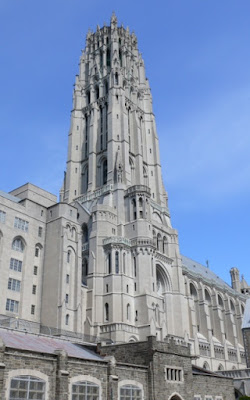A second mission in our trip to New York City was to pay our respects to the McCabe sisters: Jane's grandmother Audrey (our Socialist cheesecake), and Audrey's younger sister, Dagmar. It seems a long time ago that I wrote about the unexpected appearance of a member of Dagmar's family. Audrey had been born in 1898 and Dagmar in 1900, both in the San Juan Hill section of Manhattan. But because I was most interested in Jane's line, I simply never followed up on the two references I had seen in the 1900 and 1910 federal censuses to the younger sister—especially given how mangled the spelling of the younger sister's name apparently was. I mean, "Degnan" for "Dagmar"?
The appearance of one of Dagmar's descendants changed all that. Dagmar had lived a long, full and apparently happy life in New York City and had two daughters who were both accomplished in their fields.
Both Audrey and Dagmar died in the city: Audrey in 1991 and Dagmar in 2001. Because of the still-unexplained collapse of Audrey's family, she had, alas, died alone and was buried in a potter's field out on Long Island; Dagmar died being known and celebrated by her family. Her remains are at the Riverside Church in Manhattan.
About a year ago, our family did what we could to honor Audrey: we had a grave marker placed at her previously-unmarked grave, but none of us had yet visited her graveside to close the circle as best we could. Jane and I intended to do that, but Riverside Church being much closer to the Schomburg Center than Mt. Sinai on Long Island, we stopped in to honor Dagmar first.
If you've not been to Riverside Church in Manhattan, you're in for a treat: it's really monumental in a good sense. It sits atop at knoll overlooking the Hudson at W. 120th Street, although "sits atop" doesn't really do the 392 ft. tower justice:
The main worship space seats 2,100:
As it turns out, I had visited Riverside Church many years ago while I was living on the Lower East Side. A friend and I came up to see Maurice Duruflé conduct his Requiem with Madame Duruflé at the mighty Aeolian-Skinner. I could not hum a bar of that piece now if my life depended on it.
Anyway, following our wonderful visit to the Schomburg Center, we took the short cab ride from W. 135th to even further W. 120th St. The main entrance to the church is beneath the tower, and is made via some magnificently-carved wooden doors that I could kick myself for not getting a picture of.
We arrived at about 4:30 pm; the church closed at 5 pm. We hastened to find the memorial space where Dagmar might be and were a mite bewildered when we first heard the word describing that space: "You want to go to the columbarium?" Well, if that's where the memorials are, yes, that's where we want to go.
So back down a hallway and around the corner to the elevator—look at that huge auditorium over there; this place is huge—and back up to some intermediate level that was above the entryway but far, far below the top floor, and around the corner. The security guard with the sound of the islands in her voice opened a small arched double door in the wall and said, "Just come and tell us when you leave." We were at the columbarium.
Jane found the light switch and we went in. The room was a small vault: maybe 12 ft deep, maybe 7 or 8 ft. wide, and with about a 7 foot arched ceiling. Cozy even. No furniture other than a small book stand. The walls were plaques with names inscribed on them; behind the plaques were (we guessed) the remains of those named on the plaques. Jane murmured "This is what we're getting for Nana and Poppy in Southport," meaning the Southport (CT) Congregational Church, where the Godfreys attended for Jane's entire youth and childhood.
The small book stand held—appropriately enough—a book: a directory of those memorialized in the columbarium. It wasn't hard to find Dagmar in the book and wasn't any harder to find her plaque on the wall: it was low on the left and nearer the back than the front. Her daughter Patricia, who died just last year, was alongside.
We sat on the floor quietly for a while and admired the stillness. And then Jane said "Is that Dean Rusk's daughter?" Always well informed, I answered "Who?" Sure enough, across from Dagmar's plaque was one marked "Margaret Ann Rusk White" and beside it—presumably her husband, "Walter T. White."
Now if I had known that Secretary of State Dean Rusk's eighteen-year-old daughter Margaret had married an African-American in 1967 and that the wedding had made the cover of Time magazine, I had completely forgotten. Indeed, Secretary Rusk had sent a letter of resignation to President Lyndon Johnson, saying he did not want to cause embarrassment to the administration, but Johnson ignored the letter.
As it turned out, we had the wrong Margaret Rusk: the one in the Riverside Columbarium was born in 1918; Dean Rusk's daughter was born in 1949. As the Catholics say, "Felix culpa!", for how else would I have learned about Dean Rusk's daughter, who is my age, and who caused a wonderful consternation simply by marrying the love of her life.
I'm sorry I don't have any pictures of the columbarium. I asked Jane if she had any and she told me that she had asked if I wanted any pictures and I had said "No." What could I have been thinking?


No comments:
Post a Comment